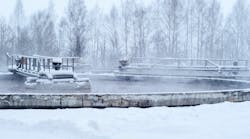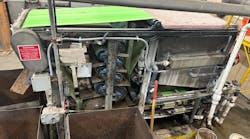The Tulsa Metropolitan Utility Authority (TMUA) provides water and wastewater services to the greater Tulsa, Okla., area. The wastewater system consists of four plants, with two plants providing a majority of the treatment capacity: Northside (42.6 mgd) and Southside (42 mgd). A recent wastewater master plan identified improvements to the digesters located at the Northside Wastewater Treatment Plant (WWTP), and the engineering firm, HDR, Inc., was retained for this work.
Thickened waste activated sludge and primary sludge are currently anaerobically digested (mesophilic) and stored for up to six months in lagoons before being applied to agricultural lands. The Northside WWTP is equipped with four anaerobic digesters. Of the four, two are inoperable. The remaining two digesters marginally allow the plant to meet Class B sludge criteria at current wastewater flows (approximately 65% of plant liquid process capacity).
An HDR study evaluated plant records, operating procedures and future sludge production quantities, and recommended improvements to ensure effective solids stabilization at the current plant liquid process capacity of 42.6 mgd and future expanded plant liquid process capacity of 48 mgd. In addition to providing capacity to process the solids, TMUA also set a goal that the project effectively address anticipated regulations and trends.
Regulations & trends
The U.S. EPA currently has two classifications for biosolids, as defined in the federal Part 503 regulations, based on the potential level of pathogens: Class A (more stringent) and Class B. In general, Class B biosolids are not considered pathogen-free and are subject to restrictive disposal criteria. Application of Class A biosolids as defined by EPA, however, is not restricted. Consequently, producing Class A biosolids can open many more opportunities for land applications or other uses than a lesser treatment process.
Due to increasing public pressure and a 2002 National Research Council report recommending an update of the Part 503 regulations, it is anticipated that EPA may change pathogen requirements in the next update of Part 503.
Solids stabilization alternatives
The obvious short-term solution to the marginal digester capacity was to rehabilitate and return Digesters 1 and 2 to service. This would have increased the capacity so Class B biosolids could be reliably produced at current loading rates. As wastewater flows increased, however, additional digester capacity would be required.
In addition to meeting current regulatory criteria, the study sought to determine how to phase in processes that would produce Class A biosolids so capital funds for this project would not be wasted should Tulsa decide or be forced to upgrade to Class A.
Many Class A options were screened and eliminated (lime stabilization, composting, heat drying, thermophilic aerobic digestion) due to high implementation costs, incompatibility with existing infrastructure and/or TMUA preference. Only processes that would not change existing dewatering, storage and land application methods were considered. The following processes were selected for further consideration.
- Pasteurization followed by mesophilic, anaerobic digestion (Class A);
- Batch-operated thermophilic anaerobic digestion/temperature phased anaerobic digestion (TPAD) (Class A);
- Batch-operated thermophilic (two-stage) anaerobic digestion (TAD) (Class A); and
- Anaerobic, mesophilic digestion (Class B).
Pasteurization process
The pasteurization process involves heating the sludge to 158°F and maintaining that temperature for a minimum of 30 minutes to achieve pathogen reduction. This is accomplished using heat exchangers and tankage or piping to provide a 30-minute detention time at 158°F. All biosolids particles processed using this alternative must be subjected to the EPA-specified time-temperature regime, which means that batch or true plug-flow processing must be employed—continuous flow processes with a detention time on or above the time-temperature curve are not acceptable.
Mesophilic digestion following the pasteurization process is required for volatile solids destruction and vector attraction reduction, but the Class B requirement of 15 days detention time is no longer required. However, the Tulsa design provides 15 days detention time unless digesters are out of service. Loading rates indicated that a pasteurization system and one new digester would be required at the projected ultimate capacity.
Thermophilic anaerobic digestion
Two alternatives involving a combination of thermophilic and mesophilic digestion were considered. Due to the Part 503 regulations requiring that all sludge particles meet the time-temperature curve to classify as Class A biosolids, any thermophilic digestion/TPAD process must be operated in batch mode to comply with the regulations, and at 131°F, this requires a minimum holding time of 24 hours.
Alternatively, extensive sampling must be conducted to prove Class A compliance. TMUA had previously tried a sampling program for a thermophilic digestion process at another WWTP, which was later abandoned. Therefore, only batch-operated thermophilic/TPAD alternatives were considered.
Minimum temperatures must be maintained in the batch thermophilic digesters to qualify as Class A under Part 503 regulations. This would require that the heat exchange systems be designed conservatively, and that the heat exchange systems be capable of keeping the digester temperature within a relatively tight range to avoid overheating. The thermophilic digestion process has been found to fail at temperatures above approximately 144°F.
The batch processing criteria for this option created difficult operating scenarios as well as infrastructure issues. Operation with the existing digesters would require a complicated sequence of filling and draining. In addition, sludge transfer pipes and pumps and heat exchangers would have to be large to drain/fill digesters in the batch mode.
Two-stage TAD
Two-stage TAD would require all anaerobic digesters at the Northside WWTP to be operated at thermophilic temperatures. Pathogen regrowth and plant odors were potential problems identified during conceptual design. Pathogen regrowth has been an issue with processes that do not include mesophilic digestion downstream of the pasteurization or high temperature processing.
There may be increased odor potential at the plant and in the final biosolids product with this process since thermophilically digested solids contain much higher levels of soluble organics and slightly higher levels of ammonia.The batch operation presents significant operational and infrastructure challenges as well.
Class B anaerobic, mesophilic digestion
This option would continue the same process currently employed at the Northside WWTP. Solids loading projections indicated that two new digesters would have to be constructed to provide 15 days of detention time at projected design loads at the ultimate plant capacity of 48.6 mgd.
Pasteurization recommended
HDR reviewed the net present worth cost of each alternative over a 20-year life cycle. The pasteurization and Class B alternatives were approximately equal in the net present worth (NPW) analysis. The thermophilic anaerobic digestion/TPAD and two-stage TAD alternatives were much higher than the pasteurization/Class B NPW values. Thus, meeting the Class A criteria via pasteurization was recommended.

